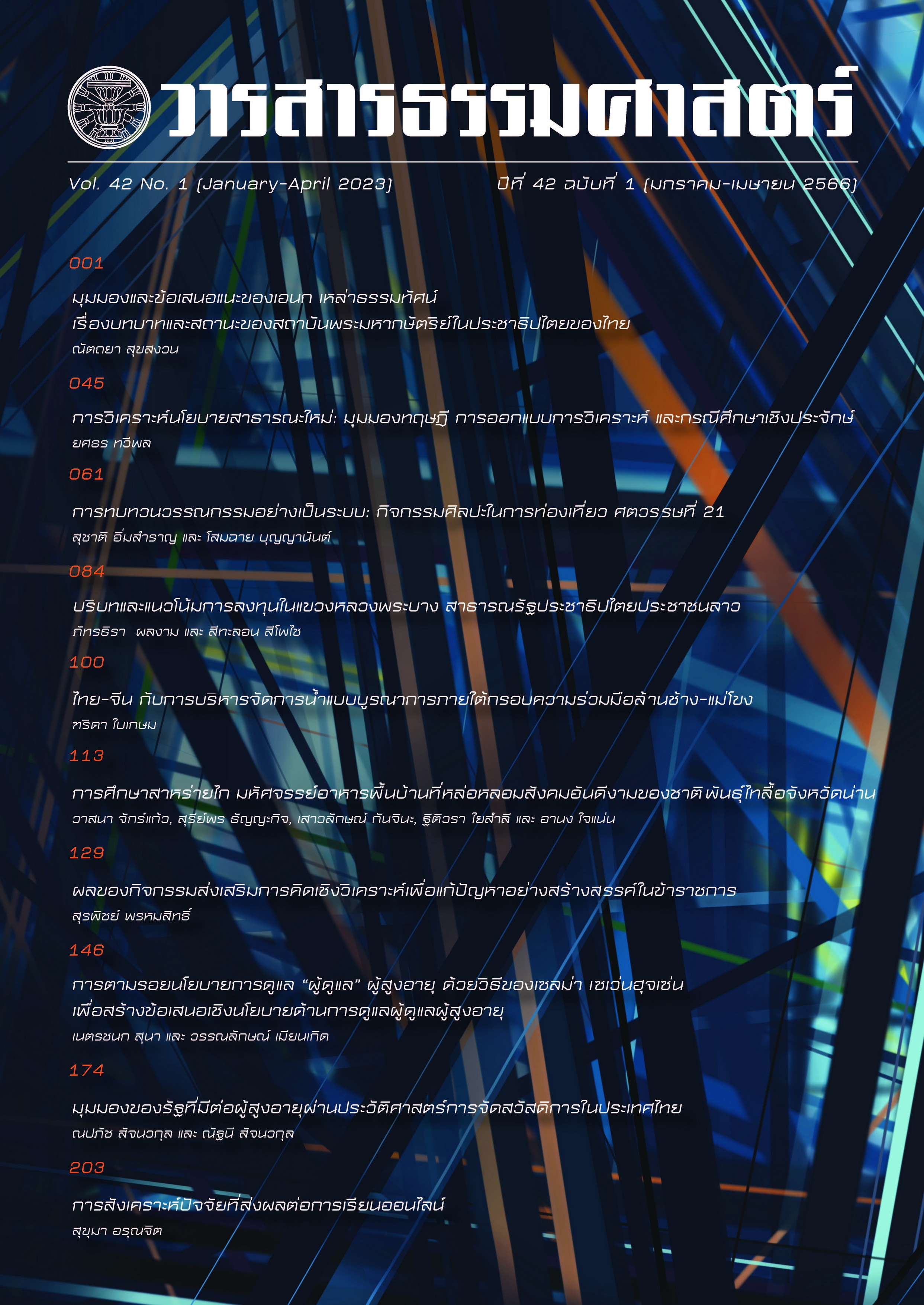Anek Laothamatas’s Perspectives and Suggestions about the Status and Roles of the Monarchy in Thai Democracy
Main Article Content
Abstract
The article aims to study Anek Laothamatas’s political thoughts in search of the new meaning of democracy for Thai politics, that correlate with the status and roles of the monarchy in Thai democracy, through perspectives and interpretations relating to the monarchy in Thai political history. This article also studies Anek’ s suggestions about the status and roles of the monarchy in Thai democracy. This research applies the methodology of political thought to study and analyze the political ideas in some issues on one’s person that have already thought and presents publicly his ideas. The study indicates that Anek’ s political thoughts on the status and roles of the monarchy in Thai democracy are publicly divided into three periods. In the first period, Anek’ s writings before 2006 presented ways of democratic development for Thailand based on principles of Western democracy, and also mentioned about the status and roles of the king and the monarchy in Thai political history. He intended to preserve the king as head of state and together with the monarchy, but he understated some clear recommendations on those issues. Secondly, along with the rise of “Thaksina-Prachaniyom” – the populist policies widely implemented by Prime Minister Thaksin Shinawatra – Anek recommended giving the status and roles of the king and the monarchy in Thai democracy through “ the Mixed Regime”. The king and the monarchy have the status of “the one” for the purpose of balancing power with other elements of democracy. Lastly, Anek approves giving the status and roles of the king and the monarchy as one of the components of the unique Thai democracy. He also recommends instituting and developing Thai democracy in the form of ‘the Mixed Regime’, in which the king and the monarchy have the status as “the one”, in order to harmonize with the genuine power and culture of Thailand
Article Details
References
คณะกรรมการศึกษาแนวทางการสร้างความปรองดอง สภาปฏิรูปแห่งชาติ. (2558). รายงานการศึกษาและข้อเสนอแนะแนวทางการสร้างความปรองดอง. กรุงเทพฯ: สำนักพิมพ์ สำนักงานเลขาธิการสภาผู้แทนราษฎร.
ชาญวิทย์ เกษตรศิริ และธำรงศักดิ์ เพชรเลิศอนันต์. (2556). ตุลา-ตุลา: สังคม-รัฐไทยกับความ รุนแรงทางการเมือง (พิมพ์ครั้งที่ 5). กรุงเทพฯ : มูลนิธิโครงการตำราสังคมศาสตร์และมนุษยศาสตร์.
ไทยรัฐ. (2560). กกต.ตั้ง 20 คกก.พัฒนาพรรคการเมืองเพื่อการปฏิรูป มี 'เอนก' นั่ง ปธ.https://www.thairath.co.th/content/877635
ประกาศสำนักนายกรัฐมนตรี เรื่อง แต่งตั้งศาสตราจารย์พิเศษ. (2553, 31 สิงหาคม). ราชกิจจานุเบกษา (เล่ม 127 ตอนพิเศษ 104 ง, น. 17). http://www.ratchakitcha. soc.go.th/DATA/PDF/2553/E/104/17.PDF
ประกาศสำนักนายกรัฐมนตรี เรื่อง แต่งตั้งคณะกรรมการปฏิรูปประเทศด้านต่าง ๆ. (2560, 15 สิงหาคม). ราชกิจจานุเบกษา (เล่ม 134 ตอนพิเศษ 205 ง, น. 1-6). http://www.ratchakitcha.soc.go.th/DATA/PDF/2560/E/205/111.PDF
ประกาศสำนักนายกรัฐมนตรีเรื่อง การประกาศแผนการปฏิรูปประเทศ. (2561, 6 เมษายน). ราชกิจจานุเบกษา (เล่ม 135 ตอนพิเศษ 24 ก, น. 1-2). http://www.ratchakitcha. soc.go.th/DATA/PDF/2561/A/024_1/1.PDF พรรครวมพลังประชาชาติไทย (1-8).
คู่มือผู้สมัคร สส. พรรครวมพลังประชาชาติไทย. [เอกสารอัดสำเนา]. สำนักงานพรรครวมพลังประชาชาติไทย: พรรครวมพลังประชาชาติไทย.
ยุกติ มุกดาวิจิตร และคณะ. (2561). ปริทัศน์คนเดือนตุลา. กรุงเทพฯ: มูลนิธิโครงการตำราสังคมศาสตร์และมนุษยศาสตร์.
ลิขิต ธีรเวคิน. (2551). ราชประชาสมาสัย.https://mgronline.com /daily/detail/9510000134354
วิทยากร เชียงกูล. (2538). ปัญญาชน: ชนชั้นนำในโลกยุคข้อมูลข่าวสาร. กรุงเทพฯ: มิ่งมิตร.
สุจิต บุญบงการ. (2561). 100 ปี พัฒนาการเมืองไทย ปฏิสัมพันธ์ระหว่างแนวคิดชาตินิยม อนุรักษ์นิยม เสรีนิยมและสังคมนิยม. กรุงเทพฯ: โรงพิมพ์แห่งจุฬาลงกรณ์มหาวิทยาลัย.
เอนก เหล่าธรรมทัศน์. (2536). ม็อบมือถือ: ชนชั้นกลางและนักธุรกิจกับพัฒนาการประชาธิปไตย. กรุงเทพฯ: สำนักพิมพ์มติชน.
_________. (2538). สองนคราประชาธิปไตย. กรุงเทพฯ: มติชน.
_________. (2548). พิศการเมือง. กรุงเทพฯ: สำนักพิมพ์openbooks.
_________. (2550). ทักษิณา-ประชานิยม (พิมพ์ครั้งที่ 2). กรุงเทพฯ: มติชน.
_________. (2557). แปรถิ่น เปลี่ยนฐาน: สร้างการปกครองท้องถิ่นให้เป็นรากฐานของ ประชาธิปไตย (พิมพ์ครั้งที่ 2). กรุงเทพฯ: สำนักพิมพ์มหาวิทยาลัยธรรมศาสตร์.
_________. (2558). ตะวันออก-ตะวันตก ใครสร้างโลกสมัยใหม่ (พิมพ์ครั้งที่ 3). ปทุมธานี: สำนักพิมพ์มหาวิทยาลัยรังสิต.
_________. (2558). ไทยในยุคบูรพาภิวัตน์โลกที่เปลี่ยนไป จาก 14 ตุลาคม 2516 ถึง 14 ตุลาคม 2558. กรุงเทพฯ: โรงพิมพ์เดือนตุลา.
_________. (2558). บูรพาภิวัตน์(พิมพ์ครั้งที่ 2). กรุงเทพฯ: มูลนิธิสถาบันสร้างสรรค์ ปัญญาสาธารณะ.
_________. (2558). ลดอำนาจรัฐ เพิ่มอำนาจประชาชน: อ่านและสอนที่จอห์นส์ ฮ้อพกินส์(พิมพ์ครั้งที่ 3). กรุงเทพฯ: มูลนิธิสถาบันสร้างสรรค์ปัญญาสาธารณะ.
_________. (2559). เพ่งประชาธิปไตยโลก พิศประชาธิปไตยไทย. นนทบุรี: มูลนิธิ สถาบันสร้างสรรค์ปัญญาสาธารณะ.
_________. (2560). เอนกทรรศน์. กรุงเทพฯ: สถาบันคลังปัญญาด้านยุทธศาสตร์ชาติ วิทยาลัยรัฐกิจ มหาวิทยาลัยรังสิต.
_________. (2561). ราชาธิปไตย. นนทบุรี: มูลนิธิสถาบันสร้างสรรค์ปัญญาสาธารณะ.
_________. (2562). เค้าโครงความคิดพินิจการเมืองไทย. นนทบุรี: มูลนิธิสถาบัน สร้างสรรค์ปัญญาสาธารณะ.
_________. (2562). พระมหากษัตริย์กับความเป็นไทย. กรุงเทพฯ: สถาบันคลังปัญญา ด้านยุทธศาสตร์ชาติ วิทยาลัยรัฐกิจ มหาวิทยาลัยรังสิต.
_________. (2563). ทวิทรรศน์: ผสานตะวันตก-ตะวันออก ประชาธิปไตย ประชาสังคม การนำและการพัฒนา. นนทบุรี: มูลนิธิสถาบันสร้างสรรค์ปัญญาสาธารณะ.
เอนก เหล่าธรรมทัศน์ และวลัยพร รัตนเศรษฐ. (2557). รัฐประศาสนศาสตร์พลเมือง. กรุงเทพฯ: สำนักพิมพ์มหาวิทยาลัยธุรกิจบัณฑิตย์.
THE STANDARD TEAM. (2563). ปฏิรูปสถาบันให้เป็นราชประชาสมาสัย ราชกับประชาอยู่ร่วมกัน คือ ทางออกเดียวของประเทศไทย. https://thestandard.co/institutionalreform-to-become-the-royal-pracha-samasai/
Laothamatas, A. (1984). Post-World War II Agricultural Development Policy in Taiwan and South Korea. (Master of Arts, University of Georgia).
_________. (1988) . Business and Politics in Thailand: New Patterns of Influence. Asian Survey, 28 (4), 451-470.
_________. (1992). Business Associations and the New Political Economy of Thailand: From Bureaucratic Polity to Liberal Corporatism. Boulder, Colo.: Westview Press.
_________. (1995). The Politics of Structural Adjustment Reform in Thailand: A Political Explanation of Economic Success. in MacIntyre, A.J. and Jayasuriya, K. (eds), The dynamics of economic policy reform in South-East Asia and the South-West Pacific, (32-49). Kuala Lumpur: Oxford University Press
_________. (1996). A Tale of Two Democracies: Conflicting Perceptions of Elections and Democracy in Thailand. in R.H. Taylor (eds), The Politics of Elections in Southeast Asia, (201-223). New York: Woodrow Wilson Center Press
_________. (eds). (1997). Democratization in Southeast and East Asia. Singapore: Institute of Southeast Asian Studies; Chiang Mai: Silkworm Books.
Bagehot, W. (1867). The English Constitution. Oxford: Oxford University Press
Bogdanor, V. (1995). The Monarchy and the Constitution. Oxford: Clarendon Press
Doner, R. F., & Laothamatas, A. (1994 ). Thailand: Economic and Political Gradualism. in Haggard, Stephan and Webb, Steven B. (eds), Voting for reform: democracy, political liberalization, and economic adjustment, (411-452). Washington, D.C.: Oxford University Press, for World Bank
Jed, W. A. (2013). Constitutional Change and the Mixed Constitution. in Cicero on Politics and the Limits of Reason, (80-119). Cambridge: Cambridge University Press
Morrow, J. (2005). Mixed Government, Balanced Constitutions and the Separation of Powers. in History of Western Political Thought: A Thematic Introduction, (227-247). New York: Palgrave Macmillan
Pocock, J. A. G. (2009). Political Thought and History: Essays on Theory and Method. Cambridge: Cambridge University Press

